The Sand Bar, Itaparica
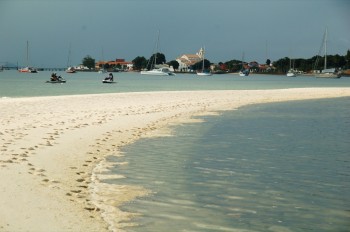
At low tide the bar is completely covered and the mini eco-system is hidden from our sight.
The tide is low. The sun having scarcely hauled itself up over the rim of the world, the sand is still damp; damp, and noisy, too. Perhaps the continual high-pitched popping is the sound of the water ebbing amongst the individual grains which make up the beach. Perhaps… but I like to think that it is made by some of the millions of tiny creatures for whom this shoal is the known world. Down there, under my feet, is another realm of existence – a realm which we humans habitually overlook although it meshes with our own.
A lesson in impermanence and interdependence
This tidal sand bar off the village of Itaparica in the Bahia de Todos os Santos is an ephemeral thing – a high-speed rendition, one might say, of our own impermanent and ever-changing world. When we first came here the sand was spread out along the underlying reef in a series of crescent shaped piles. Effectively, it consisted of a series of lowly, tide-formed dunes. Six months later, when we returned, most of the sand was piled up in the dune lying closest to the anchorage. It formed a bank – quite steep on its seaward side – perhaps six or eight feet high. Then a winter gale sent waves trundling up the channel from the sea and, almost overnight, the sand bar was transformed again.
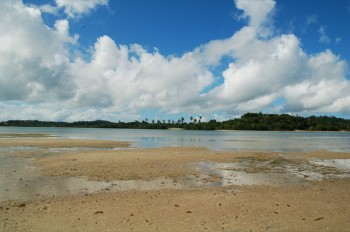
Someone should fly over it with a camera every Saturday for a year or two; or perhaps a series of satellite photos would do the trick. Sewing the shots together, like the pictures in a cartoon animation, we would see a sand bar which wriggles about like a living thing. But then, it really is a living thing. The grains of sand might not be organic – although many are no doubt derived from the shells of a zillion clams and winkles and other such things – but the sand is, in any case, merely the mortar which binds together this micro-environment.
Fiddlers
The most visible occupants of the sand bar are the crabs – itsy-bitsy fiddlers, with one tiny front limb and a gigantic one opposite it. Some of them make their homes in the pristine mounds of sand which sit atop the reef, but the smaller ones seem to prefer the place where the sand meets the mud-covered gravel, on the shoreward side of the bar. Ranging in size from the nail on my little finger to the teeniest money-spider, or a grain of sand, the fiddlers scamper about beneath my feet like insects – and, indeed, it is sometimes difficult to walk along the beach without treading on them.
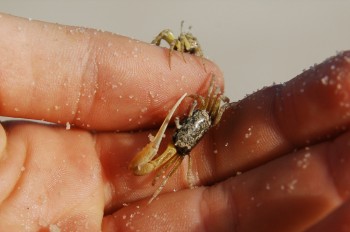
My little friends, Seamus and Bianca, don’t like the crabs. “How can you be afraid of something so tiny?” I ask them. “We are giants striding about above their heads! Don’t you see that the crabs are terrified of us?”
But then I take a closer look at the fiddlers. Like all crabs, and all members of the Arthropod phylum, they wear their skeleton on the outside so that it forms a kind of armour. They wear their eyes on long stalks. They have eight limbs and they scuttle to and fro sideways, and at quite unreasonable speed. All in all, they are not so much like animals as they are like the sci-fi monsters that the children have seen on their computer screens. They are, of course, the inspiration for those monsters; they and their arthropod kin.
How cute and wonderful would they seem if I were only half an inch high…?
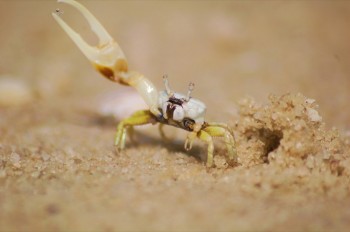
Note the eyes on stalks and the pair of tiny white arms folded up just below the mouth. There seem to be an even smaller, shorter pair above the mouth. Between them they ensure that the food gets posted into the gaping slit.
Here I am, like Alice: I’m down amongst the boulders. There are yellow-brown boulders, and translucent white boulders, and there are even a few shiny black boulders. The sun blazes down, drying them. If the wind comes up they might start to bowl along over this odd, sometimes-desert, sometimes-underwater world.
Peering over the endless field of boulders I see movement – and not just in one place but all around. All around me the seemingly-barren plain is being grazed by the monsters. The bigger ones (the males) wave their one gigantic claw like a flag. One, two, three – wave; one, two, three – wave; one, two, three – wave – the signaling goes on without cease, and whether it is a threat to the other fellas or an invitation to the girls I am not quite sure.
The armless but not quite harmless females tip-toe towards the males and then, all of a sudden, dart in and steal something. Is it a morsel of food, or is it a kiss? Impossible to say.
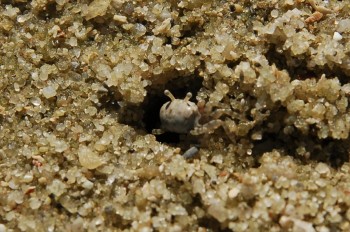
The females don’t have the enlarged, fighting claw. I guess if a female were born with a big claw she would be able to defend herself from randy males… with the result that she would not reproduce, and the characteristic would not be handed on.
Of course, the nearest I can really get to being down there amongst the fiddlers is by lying on my tummy and watching them through the zoom lens of my camera. When I first arrive the crabs in the immediate vicinity all freeze and then – if I take one more step or lie myself down-– they make a dash for the nearest burrow. After months of watching I still haven’t really got it worked out, but it seems that the burrows are open to whoever first tumbles in.
Digging a burrow must use a lot of energy. It is probably for this reason that the males, in particular, seldom wander more than a few inches from the neat, perfectly round door of their abode. They peep their eyes out of the hole and then if they deem that the coast is clear (if I haven’t moved a muscle for five minutes) they creep out and set to work. Work consists in scuttling sideways, dragging their claws through the damp sand. They do this – travelling several times in each groove and then beginning another – until finally, after a couple of hours, they have made a star-shaped pattern around their burrow. By the time the tide is set to rise again the beach is scarred all over, in the places where the fiddlers congregate, with star-shaped patterns.
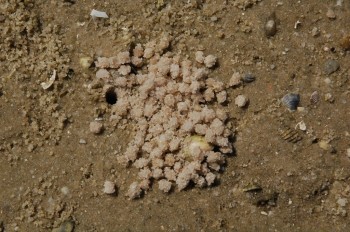
What are the crabs doing? Well, at the end of each run their limbs pass something tiny to and fro, the last, ridiculously teeny pair of arms pushing the invisible morsel into the crab’s mouth.
What could it be? Some delicate piece of detritus, perhaps; or perhaps it is another creature, even tinier than the teeniest fiddler.
Flashers
At night we have sometimes run our fingers through the sand and come across minute phosphorescent “flashes” – tiny something-or-others too small to be revealed in the photographs which I have taken of “flashes” captured in our hands. No doubt these beings are similar to the ones which we sometimes haul up at night from the sea. Again, we never manage to see the animals themselves; even with the aid of a magnifying glass we have yet to discover them. We gather up the green-glowing entity and peer down at it and find… nothing.
But the sand-bar – and, indeed, the sea, too – are alive with these near-invisible planktonic creatures. They, and the algal plankton are the basis of life in the ocean and on the sand-bar.
Puffers
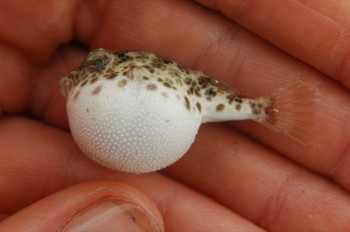
Wandering in the shallow water on either side of the sand bar, or in the pools left behind by the falling tide, one encounters other citizens of this sand-bar. The most obvious inhabitants of this region are scores of little fish. Most of them are baby puffers. Perhaps they eat plankton, too, or perhaps they find tiny crustacea too small for me to notice them.
No doubt the fish hang out here, by the beach, in order to avoid being eaten by their bigger brethren – often we see shoals of fair-sized mullet jumping as they are chased through the anchorage by something predatory – but it is strange that the puffers should be so predominant on the sand bar. Perhaps the sprats of other species dislike the way the bar comes and goes, leaving them suddenly exposed to all-comers at high water. When pursued across a sandy pool – or when under the impression that they are being pursued – the puffers sometimes bury themselves in the sand, diving in and disappearing on the instant! Presumably they are also able to do this in deep water.
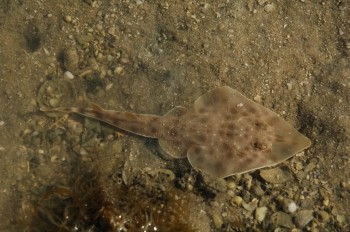
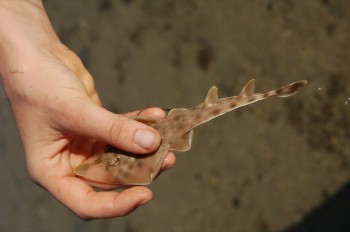
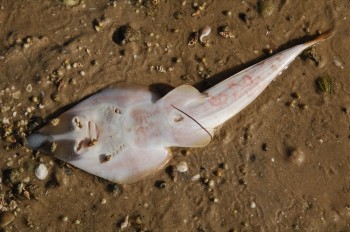
We think he might be a species of angel shark (Squatina squatina) but if anybody has any better ideas we’re open to offers.
Waders
On the shoreward side of the bar the sandy mud is pock-marked with very shallow, weedy pools. This is a place beloved of the sea birds, who wade around searching for their livelihood. Like the fish, and unlike the crabs, the birds can come and go as they please – indeed, at high water they have no choice but to go elsewhere – but still they are an important part of this micro-system. The egrets and white herons are hunting for fish. The whimbrels and others of their kind are delving for smaller prey; for shellfish, perhaps, or for tiny worms. They come here both by day and by night – indeed, I think they are probably more numerous at night when there are no people around.
The sand-bar is also a popular haunt for an eagle-like bird of prey known as Carcara, but I have yet to see one of these beings giving or taking anything from the mini world. They just loaf around in twos and threes, watching and waiting for I know not what.
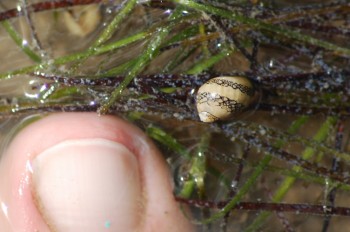
The sea-grass seems unable to get a hold here. Sometimes it gets buried under the shifting sands; at other times it is choked out by algae.
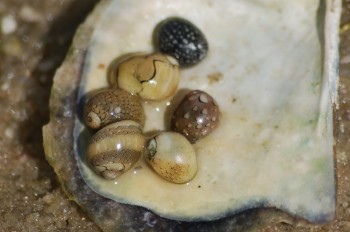
Just see what we miss when we stomp past with our mind on other things! In order to appreciate Mother Nature we often need to get down on our hands and knees and peer.
Swimmers
The entire area on the shoreward side of the bar is scattered with tiny seashells, each one of which is beautifully marked like glazed pottery. Some are yellow; some brown; some black and white.
Here also we meet a different kind of crab – a swimming crab, known to the Brazilians as siri. Actually, you can sometimes find the siri on the seaward side of the bar where they might scuttle sideways from under your feet and go darting away through the water like a fish, and you can occasionally meet them in the pools left by the retreating tide, but they are most numerous amongst the weedy pools.
When cornered the siri raise their beautiful blue forearms and threaten the towering monster: “Go on, then! Touch me if you dare!”
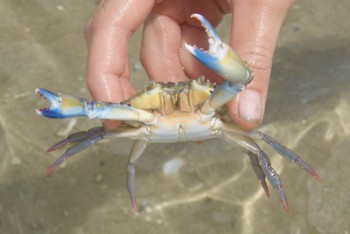
If you take a step towards him then the poor frightened creature will go shooting between your feet, his highly evolved back-legs paddling madly and his leading-edge legs trailing under the shell of his body, out of the way. The speed with which he can move is astonishing and – if he runs across your feet – quite startling!
The crabs which lurk in the pools are aiming to keep out of harm’s way. They have just shed their old shell and are waiting for the new skin to harden into a protective coat.
One of the weirdest wonders of the weird and wonderful world
On the seaward side of the sand-bar there is a shoal patch which is made up of muddy sand (as opposed to the sandy mud of the inner shoal). This is the abode of a very peculiar animal known to most people – if known at all – only from his cadaver. Just as the cuttlefish leaves behind a white boney relic, so the sand dollar (sea pansy to South Africans, and sea biscuit to the Brazilians) leaves a pretty shell. These shells are numerous on the sand bar – at low water springs I can always find half a dozen or more – but it was months before I managed to find a living, breathing sand dollar; and then, on the very next day, I found fifty in one place!
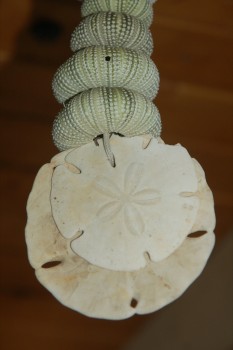
Note the hole in the side of the sea urchin. Almost all the urchins found on the sand bar have this hole; they have evidently been attacked and eaten by (I suppose) some kind of gastropod.
The living sand dollar is, in fact, very like his last remains; the only difference is that when he is alive the pansy-shaped shell is coated in red-brown velvet. I sensed, rather than saw, that my latest discovery was alive. Without eyes or mouth, he nevertheless gave forth some kind of faint energy. Looking closer I saw that the velvet flock was glistening in the sunshine; so the hairs were evidently moving in waves. When I put him in a bucket he explored the bottom in small, surprising jerks, taking an hour to circumnavigate the entire bucket.
When I put the creature in the sand he very slowly wafted it over himself until he was all but buried. Only the slits remained. This, indeed, is how I found the sand-dollar garden – a patch of fifty creatures growing in such close proximity that they almost touched one another. They seemed to exude a quiet buzz of spooky energy, as if they were communicating. As fast as I uncovered them they buried themselves again. Fifty was the number which I managed to keep track of at one time – so, in fact there may have been even more of them.
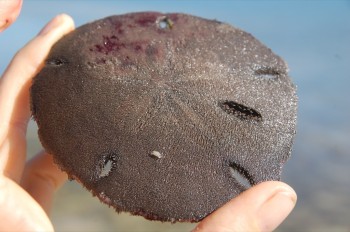
Note the teeny-weeny white crab, which presumably feeds on material trapped in the sand dollar’s “fur”.
I once found a living sand dollar which had been broken in two. Presumably somebody had trodden on it. As I knew already (from having broken the dead remains) the inside of the shell is largely occupied by a honeycomb matrix of calcium carbonate – or whatever sand-dollar shells are made of. There is little space for any organism – and, indeed, when I examined the living specimen there seemed to be almost nothing else in there; nothing except a few threads of orange goo. Truly, a very odd creature.
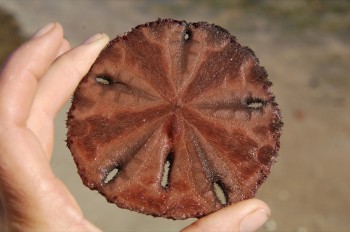
The “hairs” on the underside are slightly longer and are used to manoeuvre the shell forward and down, until the creature is just below the surface of the sand.
Whether the sand dollars live in such intimacy by choice or whether this is the only suitably soft piece of sand, I do not know. I suppose that if they wandered away from one another they might never meet up with another sand dollar!
It seems to me that a creature with a narrow niche must be perpetually threatened in an environment such as this. When the water-borne sand-dune moves, it tramples over everything. No doubt the crabs can go with the flow – they can travel with the shifting sand – but for the clams and sand dollars and many other creatures a southerly gale might be cataclysmic. Proof of this was to be seen, a few months ago, at the further end of the reef. Here, the sands had moved away denuding a patch of the underlying reef and revealing hundreds of mouldy black sea shells. Presumably they all died prematurely when they were suddenly buried.
Of course there could be another reason for the sand dollars’ close proximity. Although they have no eyes or ears it may be that they are, nevertheless, able to navigate. Perhaps, just like turtles and eels, they can find their way back to the clan breeding ground. And perhaps I was intruding on a mating meeting!
In any event, when I searched for the sand dollars again, a month later, I couldn’t find them.
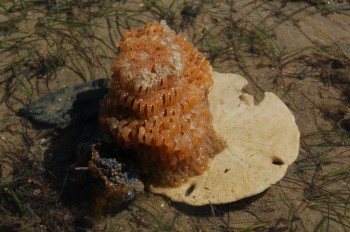
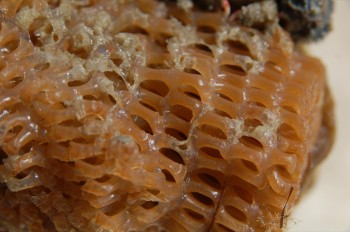
If you know, please drop us a line.
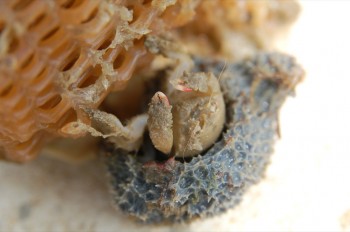
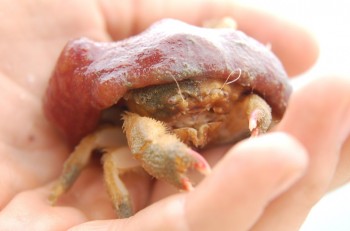
Man’s interaction with the world of the sand bar
At the weekend the sand bar is popular with folks from the city, who come here to relax. They park their motor boats in the shallows, turn on their loud music, and then, having waded ashore, they sit beneath their parasols and they eat. They don’t see the crabs or the flashing plankton; they don’t realise that they are trespassing in an alien world peopled by things which slurp sand and gobble greedily. If they did, they might be as disgusted as Seamus and Bianca.
During the week pretty much the only visitors to the sand bar are the fisher-folk and me – and the fisher-folk know a great deal about the web of life which makes up this barren seeming place.
Bait-diggers
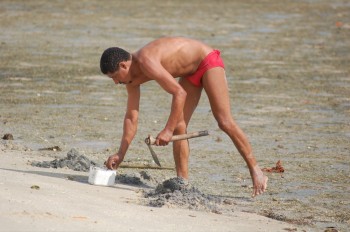
The fishermen come here to find their bait. Some of them forage in the shallow water over the mud-covered part of the bank, using a large butterfly net. The net is semi-circular in shape and is fastened to a T-shaped pole. Its lower edge is held open by the bar of the T.
The men wade along pushing the net ahead of them like a broom. At his waist each one wears a small pot-shaped basket – or kofa – in which to keep the harvest, but often, when I ask to see the prawns, they have none to show me. They trudge to and fro, trawling up a miscellany of purple and green sea urchins, brick-red starfish, brown seaweed, and dead mangrove leaves, hoping all the while for prawns and, by my estimation, finding one for every fifteen sweeps of the net. Their patience is impressive.
Worms
More commonly the men dig for bait on the edge of the soft white sand or in the grittier sand of the outer (seaward facing) mud flat. This is where the marine worms live. In some countries people use a pump to suck up worms – they place the open end of the pump over a likely looking hole, and they pull up the handle, so sucking up the sand – but these guys use a short-handled hoe. Stepping softly and swiftly towards the pin-prick mark which is the worm’s breathing hole (much smaller than the fiddler crabs’ hole) they chop, chop, chop – quickly and deftly – and if the worm has not managed to slink deep down into the sand they grab him and shove him into the kofa.
The biggest worms are as fat as sausages, and some of them have subtley shiny iridescent skins. When evicted from their dark, watery home they rear up blindly and wave their bodies about.
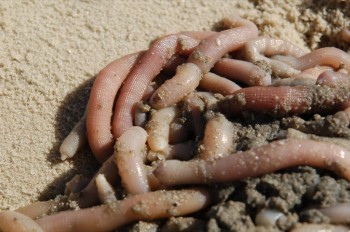
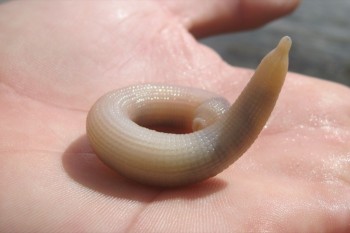
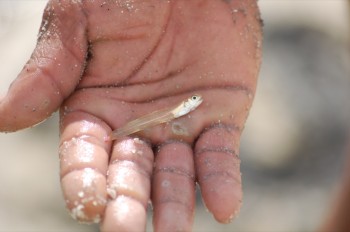
I like to walk along with the fishermen and see what else they find in the sand. Sometimes they come across tiny, near-transparent fish. “Cobra,” they will say, putting the slender thing to wriggle in my hand.
It was some time before I established that these so-called snakes are baby moray eels. At night one occasionally sees their elder brethren swimming on the surface beneath the street lights on the pier; and then they really do look like green-and-brown banded snakes.
Sometimes, if I show enough curiosity, a fisherman might give me a worm (“for bait”). I have found that the animals are quite incapable of burrowing back into the sand. Even if placed in a slurpy-sand puddle they just writhe around uncomfortably; and when I bury them then, I suspect, they suffocate. Presumably they are born in a hole under the sand and sea and live all their lives without experiencing sunlight or the dry touch of the wind.
Perhaps we are just the same; perhaps we live all our lives fixated with our experience of the world and unable to see a far bigger reality which looms all around. Perhaps we’re really just worms crawling pointlessly in the mud, or fiddlers scurrying purposefully to and fro for the sake of scurrying to and fro.
Lobsterlets
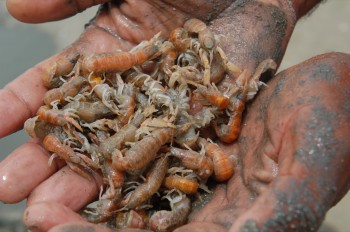
Most of these “lobsterlets” are carrying eggs. They are most visible in the animal lying on its back in the top left-hand section of the mass.
At the far end of the sand bar the fishermen seek for a different kind of bait – one which lives in colonies in the sand. This is a species of ultra-mini lobster or crayfish. From its design shape it does not appear to be suited to burrowing – but here it is anyway.
At first glance one might assume that these tiny “prawns”, as the fishermen call them, are baby lobsters newly-metamorphosed from their final, planktonic nymph stage; but they are not. Many have a clutch of orange eggs beneath their tail. Of course, the men should not be taking any kind of creature which is in its breeding season… but you try telling that to a subsistence fisherman whose home is a squat on the edge of town! Nor will you get far when you try to explain that it is his own livelihood which he is damaging by gathering up the breeding stock. If he were smart enough to grasp this fact, he would probably not be living in a shanty town and scratching a living on the sand bar.
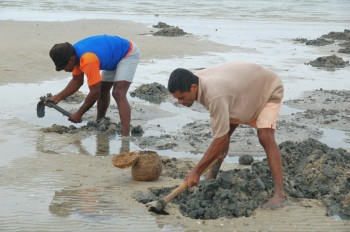
I would guess that, like their bigger brethren, the lobsterlets probably spend most of their life crawling freely on the bottom. I suspect that they only move into the sand bar to breed and lay their eggs. Hopefully, they also breed on more remote sand bars inaccessible to the fisherfolk. If not, I should say that their existence in the Bahia is doomed.
Clam-diggers
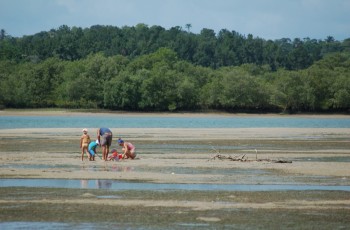
While the men pillage the muddy sand for bait, their women-folk scour it for clams. There are two kinds to be found on this particular reef. The larger sort buries itself in the sand, but the smaller lives barely below the surface. On spring tides, when a large expanse of muddy sand is uncovered, the women are dropped off on the sand bar as soon as the tide begins to fall, and they set to work at once, squatting on their haunches and scraping the ground with a spoon. As the hours pass their posture changes – first they adopt the stance favoured by women scything hay (legs straight and splayed; body doubled over); then they collapse and sit on the mud with their legs stretched out ahead of them – but at no stage during the six hour ordeal do they stop for a rest.
At the end of the day, when the boat returns, each of the six or eight women has bagged a couple of thousand clams.
Can the sand-bar sustain this kind of assault? I doubt it very much.
At night the men sometimes come ashore on the sand-bar and spread a net – illegally. They also use dynamite, in the waters nearby, killing everything in the vicinity for the sake of catching their supper. It is hard to condemn this kind of thing when they have so little and we have so much – but, again, this greed is very short-sighted. A stick of dynamite saves all the trouble of netting prawns for bait; but the next time they want prawns… there are none to be found.
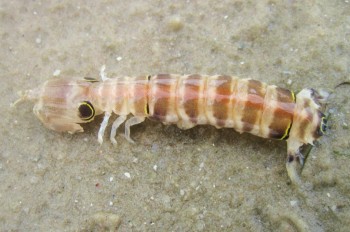
The animal’s head is at the left-hand end and is very tiny. The scary “eyes” are not even on the head. There is another set of these fake eyes on the tail.
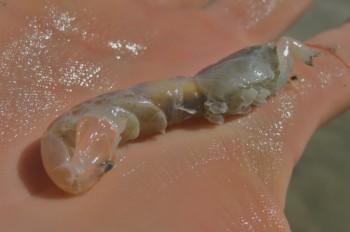
This prawn-like creature seems to have only vestigial legs. Is it evolving to live all the while in the sand, or is it undergoing a metamorphosis? Its body plan is actually very similar to the animal in the previous photo.
Oh, how we people love the security of imagined permanence!
I love the sand bar; but I have noticed that I find it hard not to become attached to the way it is right now. Like a fellow wandering into his local pub, I have my favourite dune where I like to sit and meditate. Over the weeks the dune changes shape until, eventually, it becomes clear that what I am hanging onto is no longer the best – and so, reluctantly, I choose another favourite. And so it goes on. Again, the sand bar mirrors the reality of our greater world, where we like to hang onto things – to our fitness and our families; to friends and familiar places – and keep them just as they are.
Even the time-table maintained by the sand bar is inconvenient. We note the remorseless cycle whereby it comes and goes. Sometimes it is there for us, and sometimes it is not. We note the cycle – but our lives are not synchronised to the rhythm, and so we lose track of it. “How much more convenient it would be if the sand-bank kept regular hours! Then we could walk the dog at the same time each day, and we wouldn’t have to look at the tide-table before planning our beach parties!”

Ever changing, the sand bar is also ever new. Each high tide washes away the footprints and fills in the fishermen’s excavations. Each ebb presents me with a world as clean and perfect as a field of freshly fallen snow. Sometimes I just stand and look at my favourite dune, glorying in its perfect curves and its wonderfully smooth, slightly sparkly surface, and resisting for a while the temptation to maul it with my own marks.
I love the sand bar by day. I love it for the unseen world hidden within it, and I love it for the way it comes and goes. I love to see the tide creeping relentlessly over the shallows and then licking at the icing-sugar sand hills; I love to see it swallowing them up.
But best of all I love the sand bar by night, when the fiddlers are hiding in their holes and the fishermen are tucked up with a glass of cheap rum or a bottle of beer. At night, the sand bar chatters away to itself. The fish plop in the shallows, the whimbrel’s mellow whistle comes to me from somewhere close by, and a heron scolds sharply. Something pop-pops inside the sand. Perhaps it’s the night crabs, as I call them – long-legged creatures with rounded shells somewhat larger than a walnut. I would not know of their existence but for the fact that the dog digs them out – and then backs off nervously as they wave their claws in that menacing fashion.
Where do these crabs hang out during the day, I wonder? Poppy has never shown any interest in digging on the beach during the day.
At night the weedy shallows between the sand dunes are slightly scary. I put my feet into the blackness, vaguely trusting – or hoping – that I won’t tread on a moray eel.
Under the full moon the sands really do look like snowdrifts. And when there is no moon at all then the place is a dark secret. Perhaps the night crabs are not the only ones who hide here; perhaps other eyes watch my feet passing.
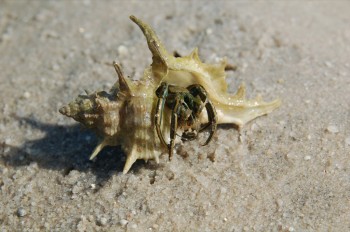
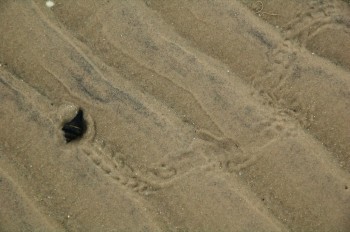
Best of all, at night, I like to listen to the tide returning, for when you sit and listen it seems to be galloping up, and it seems to represent time itself rushing by. With the wind wafting through my hair, and the sky above me seeming as near as the lights of the shore, I find myself in a world which encompasses all of reality, from the microscopic millions in the sand I sit upon all the way out – across the village, across the country, around the globe – and into the million other solar systems spinning with us through space.

Ahoi all of you!
First of all, sorry I didn’t write before, have a good new year, follow your course, continue writing the wonderful articles about what you are seeing, where you are, I appreciate it so much. Hope you all are in best state of health…
Thank you again for this really informative and interesting “lesson” about the sea life of your place – over there! Yes, our world
could be so wunderful, clean if men would be more conscious about what they are doing.
Cari saluti, in culo alla balena
from Bea, Liguria
the last two crustacean look like a mantis shrimp. I’m not so sure if mantis shrimp lay their eggs in the sand.
Hi and great blog!
The baby ray is a Shovel-Nose Shark, the Tiny Lobsters are Ghost Shrimp the Lobster-like crustacean is a Mantis Shrimp (watch out! Handle with care.) and the other looks like a type of Ghost Shrimp. I grew up by the ocean with a all of these animals and more.
Thank-you, Amir; thank-you, Cole.
I was going to ask why you told us to watch out for the mantis shrimp, but then I looked it up on wikipedia.
Whoo! He looks as innocent as pie; he certainly doesn’t look as if he could gash anybody! Many thanks for the advice. I don’t think we’ll handle the next one we meet…!